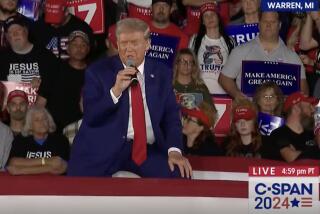‘Uncertainty’ isn’t the real reason they’re not hiring
- Share via
Over the last few economically stagnant months, a new explanation has emerged for why businesses are reluctant to hire more workers and otherwise gear up for recovery.
The reason, you see, is “uncertainty.” The idea seems to be that Washington’s will-they-or-won’t-they dithering over extending the Bush tax cuts, the advent of healthcare reform, financial reform, etc., etc., etc., has unsettled the business landscape so horribly that decision makers are huddled under duvets, gnawing their knuckles in fear and bewilderment.
This argument raises a number of important questions. The first is: When did American business leaders turn into such wusses? This nation spent three decades facing the threat of nuclear annihilation from the Soviet Union. That was uncertainty, and it hovered over the most prosperous period in our history. Now CEOs are crabbing about not knowing if their top marginal federal income tax rate will stay at 35% or rise all the way to 39.6.
In an op-ed round robin hosted by The Times’ editorial board last month, a USC business professor listed among the uncertainties killing confidence that “businesses don’t know what will happen to interest rates.”
But businesses never know what will happen to interest rates, any more than I know who’ll be in the next Super Bowl. No one who knows what will happen to interest rates has to run a business at all; he can just sit back and play the bond market with perfect knowledge, and become the richest person in the world.
The principal retailer of the “uncertainty” trope is the U.S. Chamber of Commerce, which trots the term out so frequently you’d think it collects a royalty for every repetition by a commentator on, say, CNBC. But the chamber’s “certainty” isn’t the one you find in the dictionary, which defines it as “freedom from doubt; confidence; sureness.” The chamber’s definition of “certainty” is “less regulation; lower taxes.”
How do we know this? Consider the form letter the chamber asks members to send to Congress, urging the lawmakers to “end the tax uncertainty plaguing the business community” by extending the Bush tax cuts. According to the dictionary definition, “uncertainty” over taxes could be ended by letting the tax cuts lapse, or by voting to extend them for the middle class but not for the wealthy. The chamber’s lexicon doesn’t recognize the latter outcome.
One wonders where the chamber gets the idea that uncertainty about taxes and regulation is such a big deal for business. If you listen to what actual business owners are saying, what’s mainly holding back hiring and expansion isn’t regulatory “uncertainty,” but lack of demand.
For more than a year, the monthly small-business economic trends survey of the National Federation of Independent Business has listed “poor sales” as business’ single biggest problem. In the most recent survey, that factor was listed by 30% of respondents, swamping “taxes” (20%) and “government requirements and red tape” (17%).
That’s important because the policy responses to “regulatory uncertainty” and to poor demand are very different. In the first case, you kill consumer protections, eviscerate oversight of industries such as oil drilling, mortgage and securities trading and healthcare, and shift the tax burden downward toward the middle class — in chamber-speak, that’s called “broadening the tax base.”
In the latter case, you might want to spur demand by extending unemployment coverage, enacting more stimulus and not needlessly scaring people about their Social Security retirement, which only provokes them to cut back on spending now. You might also want to avoid imposing a government wage freeze at this particular moment, as President Obama has just proposed.
What really gives the lie to the “uncertainty” argument is its long history. The idea that federal regulation, taxation and deficit spending unnerved business to the point of paralysis was aired out in the ‘30s. It was dismissed then by no less a figure than Joseph Schumpeter, the herald of the entrepreneurial age and the conservative economist least likely to be mistaken for John Maynard Keynes. Schumpeter pointed to the argument as one of those that “fully merit the shrugging of shoulders with which they are usually met.”
These days, the “uncertainty” argument relies on the claim that regulation is out of control, and about to get worse. This summer the American Enterprise Institute threw a fit when it discovered that the new financial reform act came to 2,319 pages. The bill that created the Federal Reserve system was only 31 pages, it observed, adding: “The numbers pretty much speak for themselves.”
But what do the numbers tell us, other than that the folks at AEI can count into the low four figures? First of all, the Federal Reserve bill they mention was enacted in 1913. Fun as it may be to evoke America’s golden past, keep in mind that the nation’s gross domestic product in 1913 was $39 billion ($600 billion in current dollars). Today it’s nearly $15 trillion. So it’s proper to think of today’s economy as a teensy bit more complicated than that of a century ago.
Second, that 31-page bill created a Federal Reserve System that was completely unable to cope with the onset of the Great Depression, and even played a key role in turning a plain-vanilla downturn into the Great Depression. Not my conclusion — Milton Friedman’s. And he’s a conservative saint.
The original Fed was upgraded by the Banking Act of 1935, which clocked in at about 50% longer than its predecessor. (GDP that year was $73 billion — $865 billion, inflation-adjusted.) That Fed proved completely unable to cope with the economic downturn of 2008.
So now we have the financial reform law of 2010, which refashions the Fed and the rest of our financial regulatory structure. Yes, it’s long and detailed, but history warns us that it may not be detailed enough. How much do you want to bet that if it were 31 pages, its opponents would be screaming that Congress was leaving too much to the judgments of “unelected bureaucrats”?
The new law has to deal with realities that didn’t exist in 1935 or 1913, such as derivatives and mortgage securities and international trading and blind risk-taking by bankers in markets they don’t understand. Bankers and financiers and their water-carriers at the Chamber of Commerce have some nerve complaining about the regulation required to keep them from wrecking the economy the rest of us live in.
You want certainty? I’m certain that instead of making loans to businesses that need them, the banking bonus babies of the future will find new ways to lose money, and a future Congress will have to clean up the mess. I’m certain that the Chamber of Commerce of that era will argue that we need less regulation, not more, and I’m certain they’ll be lying.
Michael Hiltzik’s column appears Sundays and Wednesdays. Reach him at [email protected], read past columns at latimes.com/hiltzik, check out facebook.com/hiltzik and follow @latimeshiltzik on Twitter.
More to Read
Inside the business of entertainment
The Wide Shot brings you news, analysis and insights on everything from streaming wars to production — and what it all means for the future.
You may occasionally receive promotional content from the Los Angeles Times.











